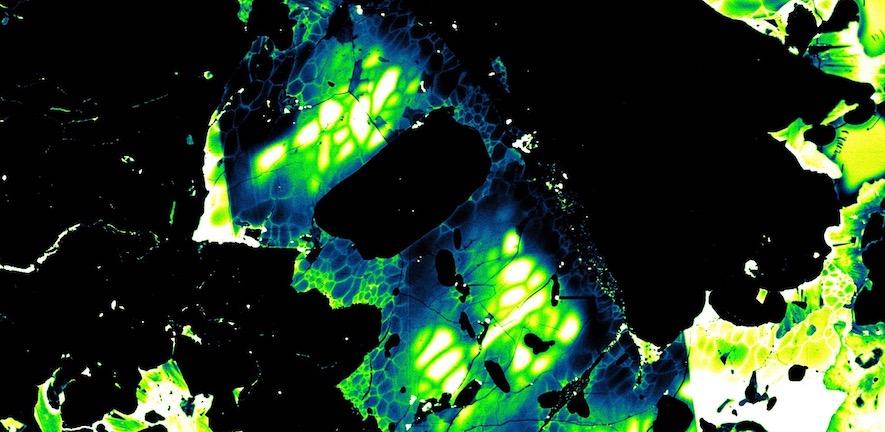
Submitted by Administrator on Thu, 24/02/2022 - 11:17
Geologists have identified a new way of tracing collisions between asteroids, using microscopic mineral textures, which could greatly enhance our understanding of how planets and asteroids interacted across much of Solar System history.
Planetary histories are shaped, and perhaps recorded, by collisions. For example, the Earth-Moon system is thought to have formed from the collision between two Mars-sized entities, debris from which should have scattered across the Solar System, violently marking its passage by further collisions with asteroids. Meteorites falling to Earth today provide samples of asteroids that we can study, and potentially use to interrogate ancient events.
“Meteorites are an archive of ancient events that rocks on Earth may not have been around to witness,” said Craig Walton – a graduate student in Cambridge’s Department of Earth Sciences, who led the research. “Meteorites may record both when collisions took place, and the conditions of those collisions. In this way, meteorites are a fantastic record of Solar System evolution. The problem is that we only have small pieces to work with, which arrive randomly from locations throughout our Solar System.”
Intriguingly, some meteorites appear to preserve tentative evidence in their mineralogy and mineral ages for an episode of heightened collisions around four and a half billion years ago – coincidental with when we think the Earth-Moon giant impact took place. However, this evidence has long been controversial, owing to the uncertainties involved in interpreting evidence from meteorites for ancient versus recent collisions. Geologists from the University of Cambridge believe that mineral textures offer a way to see through this long-standing uncertainty.
The researchers have identified a correlation between the micro-texture and measured mineral collision ages in the much-studied Chelyabinsk meteorite – a famous space rock that fell in Russia in 2013, which preserves extensive evidence for collision-induced melting on its asteroidal parent body. The researchers say the results, reported in Communications Earth and Environment, could mean that tracing important events in early Solar System history with meteorites is now a real possibility.
“Combining collision ages with mineral textures is allowing us to understand what meteorites have to say about Solar System history,” said Dr Oliver Shorttle of Cambridge’s Department of Earth Sciences and Institute of Astronomy, who supervised the project.
Mineral micro-textures inform us on the relative sequence of collisional events recorded by meteorites, whereas mineral ages place absolute dates on those same events. By identifying two distinct events in the mineral textures of Chelyabinsk and demonstrating that each has a distinct age – separated in time by almost 4 and a half billion years – the researchers were able to piece together the history of the asteroid from which Chelyabinsk originated.
Minerals in Chelyabinsk record an early collision event in which the rock was heated to thousands of degrees kelvin. In this event the mineral grains experienced extreme pressures and deformed in a plastic manner – information that was obtained by studying mineral micro-texture. Some of these same minerals then later experienced brittle deformation, implying elevated pressure in the absence of high temperatures, during a second collision that affected the Chelyabinsk parent asteroid. By performing mineral age analyses in the vicinity of these contrasting micro-textural features, two collision ages were obtained: one at four thousand four hundred and seventy million years ago, recording a high temperature event, and one mere millions of years ago, recording a lower temperature event.
The researchers infer from their results that the Chelyabinsk parent body asteroid experienced a massive collision early in Solar System history, had a quiescent middle age, and then recently experienced a disruptive collision that fragmented the parent body and sent Chelyabinsk on a path that led, eventually, to Earth.
There are numerous other meteorites, all from different parent asteroids, which preserve similar ages to Chelyabinsk. This is a signature which has been tentatively interpreted as evidence for a dramatic event at the time – perhaps a record of Earth-Moon formation, or alternatively as reflecting collisions induced by the orbital migration of the giant planets, such as Jupiter. Having demonstrated that mineral ages robustly record ancient collisions, the researchers now feel more confident in beginning to interpret the wider meteorite record of Solar System history.
“There is now a clear opportunity for astrophysicists to start testing ideas about Solar System evolution with meteorite collision ages, which mineral textures will help us to correctly interpret,” said Walton. “There are many more meteorites waiting to tell us about their bumpy ride through space – together, they may help to tell us the story of how the Solar System as we know it came to be.”
